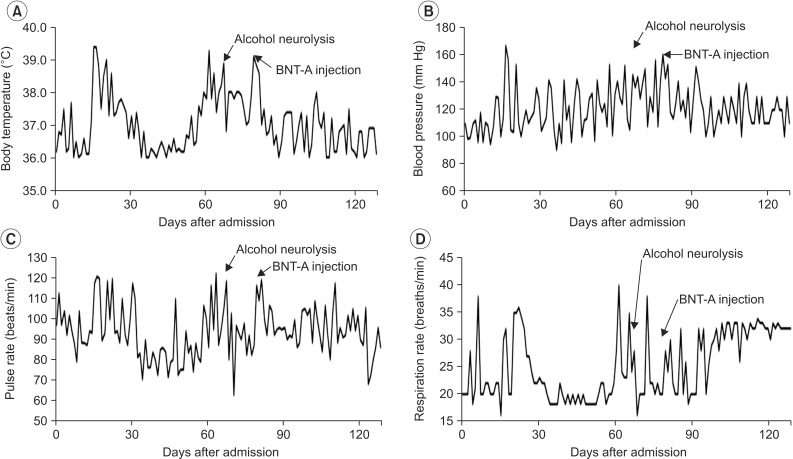Ann Rehabil Med.
2015 Apr;39(2):308-312. 10.5535/arm.2015.39.2.308.
Paroxysmal Autonomic Instability With Dystonia Managed Using Chemodenervation Including Alcohol Neurolysis and Botulinum Toxin Type A Injection: A Case Report
- Affiliations
-
- 1Department of Rehabilitation Medicine, National Rehabilitation Center, Seoul, Korea. asfreelyas@gmail.com
- KMID: 2273054
- DOI: http://doi.org/10.5535/arm.2015.39.2.308
Abstract
- Paroxysmal autonomic instability with dystonia (PAID) is a rare complication of brain injury. Symptoms of PAID include diaphoresis, hyperthermia, hypertension, tachycardia, and tachypnea accompanied by hypertonic movement. Herein, we present the case of a 44-year-old female patient, who was diagnosed with paraneoplastic limbic encephalopathy caused by thyroid papillary cancer. The patient exhibited all the symptoms of PAID. On the basis that the symptoms were unresponsive to antispastic medication and her liver function test was elevated, we performed alcohol neurolysis of the musculocutaneous nerve followed by botulinum toxin type A (BNT-A) injection into the biceps brachii and brachialis. Unstable vital signs and hypertonia were relieved after chemodenervation. Accordingly, alcohol neurolysis and BNT-A injection are proposed as a treatment option for intractable PAID.
Keyword
MeSH Terms
Figure
Cited by 1 articles
-
Botulinum Toxin A Injection into the Subscapularis Muscle to Treat Intractable Hemiplegic Shoulder Pain
Jeong-Gue Choi, Joon-Ho Shin, Bo-Ra Kim
Ann Rehabil Med. 2016;40(4):592-599. doi: 10.5535/arm.2016.40.4.592.
Reference
-
1. Blackman JA, Patrick PD, Buck ML, Rust RS Jr. Paroxysmal autonomic instability with dystonia after brain injury. Arch Neurol. 2004; 61:321–328. PMID: 15023807.
Article2. Ramdhani NA, Sikma MA, Witkamp TD, Slooter AJ, de Lange DW. Paroxysmal autonomic instability with dystonia in a patient with tuberculous meningitis: a case report. J Med Case Rep. 2010; 4:304. PMID: 20831807.
Article3. Comella CL, Leurgans S, Wuu J, Stebbins GT, Chmura T. Dystonia Study Group. Rating scales for dystonia: a multicenter assessment. Mov Disord. 2003; 18:303–312. PMID: 12621634.
Article4. Boeve BF, Wijdicks EF, Benarroch EE, Schmidt KD. Paroxysmal sympathetic storms ("diencephalic seizures") after severe diffuse axonal head injury. Mayo Clin Proc. 1998; 73:148–152. PMID: 9472998.
Article5. Sneed RC. Hyperpyrexia associated with sustained muscle contractions: an alternative diagnosis to central fever. Arch Phys Med Rehabil. 1995; 76:101–103. PMID: 7811167.
Article6. Goh KY, Conway EJ, DaRosso RC, Muszynski CA, Epstein FJ. Sympathetic storms in a child with a midbrain glioma: a variant of diencephalic seizures. Pediatr Neurol. 1999; 21:742–744. PMID: 10580889.
Article7. Thorley RR, Wertsch JJ, Klingbeil GE. Acute hypothalamic instability in traumatic brain injury: a case report. Arch Phys Med Rehabil. 2001; 82:246–249. PMID: 11239318.
Article8. Cuny E, Richer E, Castel JP. Dysautonomia syndrome in the acute recovery phase after traumatic brain injury: relief with intrathecal Baclofen therapy. Brain Inj. 2001; 15:917–925. PMID: 11595088.
Article9. Goddeau RP Jr, Silverman SB, Sims JR. Dexmedetomidine for the treatment of paroxysmal autonomic instability with dystonia. Neurocrit Care. 2007; 7:217–220. PMID: 17603760.
Article10. Taylor JJ, Woolsey RM. Dilute ethyl alcohol: effect on the sciatic nerve of the mouse. Arch Phys Med Rehabil. 1976; 57:233–237. PMID: 179494.
- Full Text Links
- Actions
-
Cited
- CITED
-
- Close
- Share
- Similar articles
-
- Improvement of Lingual Dystonia Following Cerebellar Infarction through Botulinum Toxin Injection: a Case Report
- Botulinum Toxin Injection Therapy for Lingual Dystonia: A Case Report
- The Complications of Botulinum Toxin Type A Chemodenervation in Strabismus
- The Complications Developed after Repeated Botulinum Toxin Injection
- Precise Muscle Selection Using Dynamic Polyelectromyography for Treatment of Post-stroke Dystonia: A Case Report



